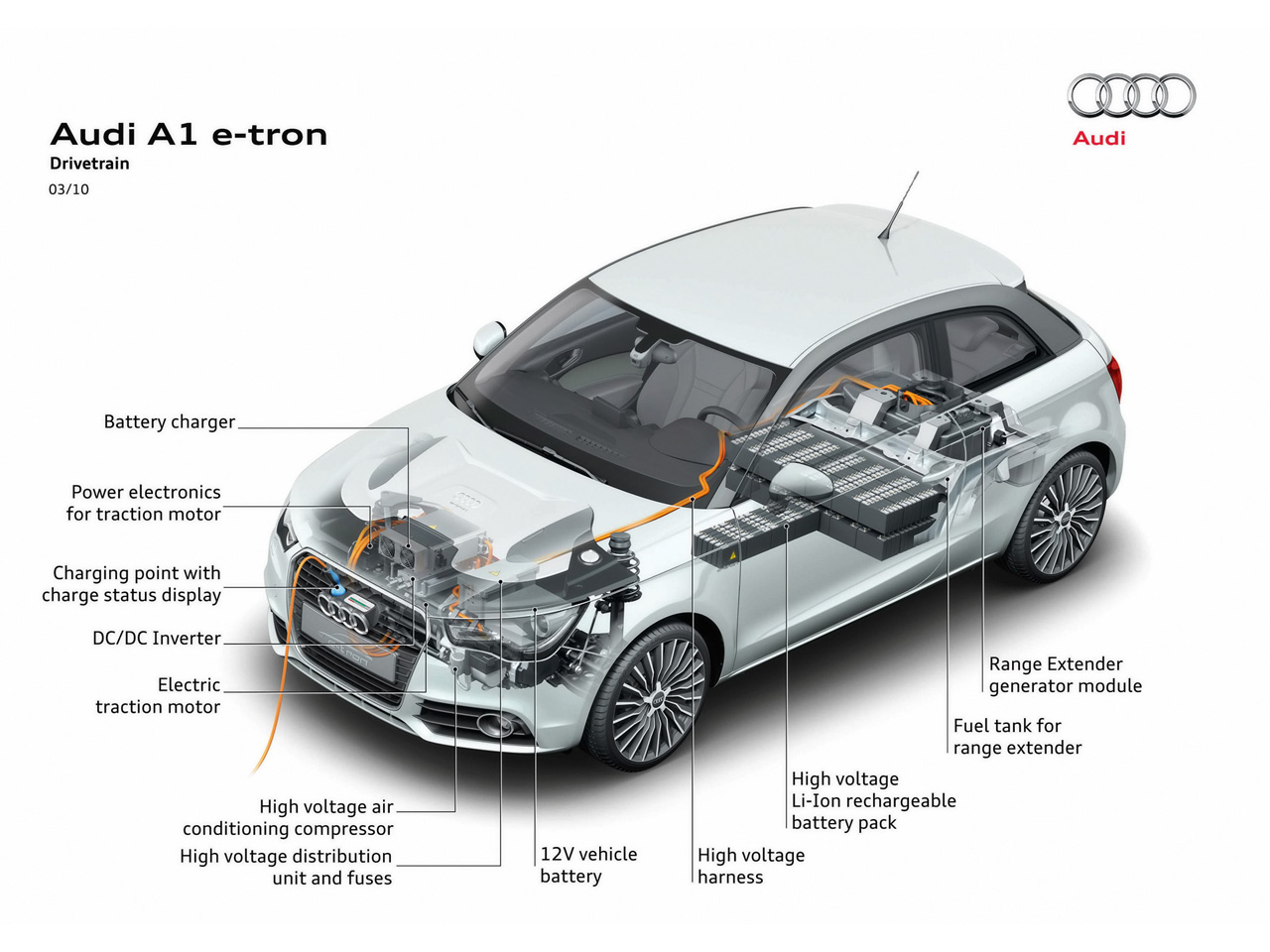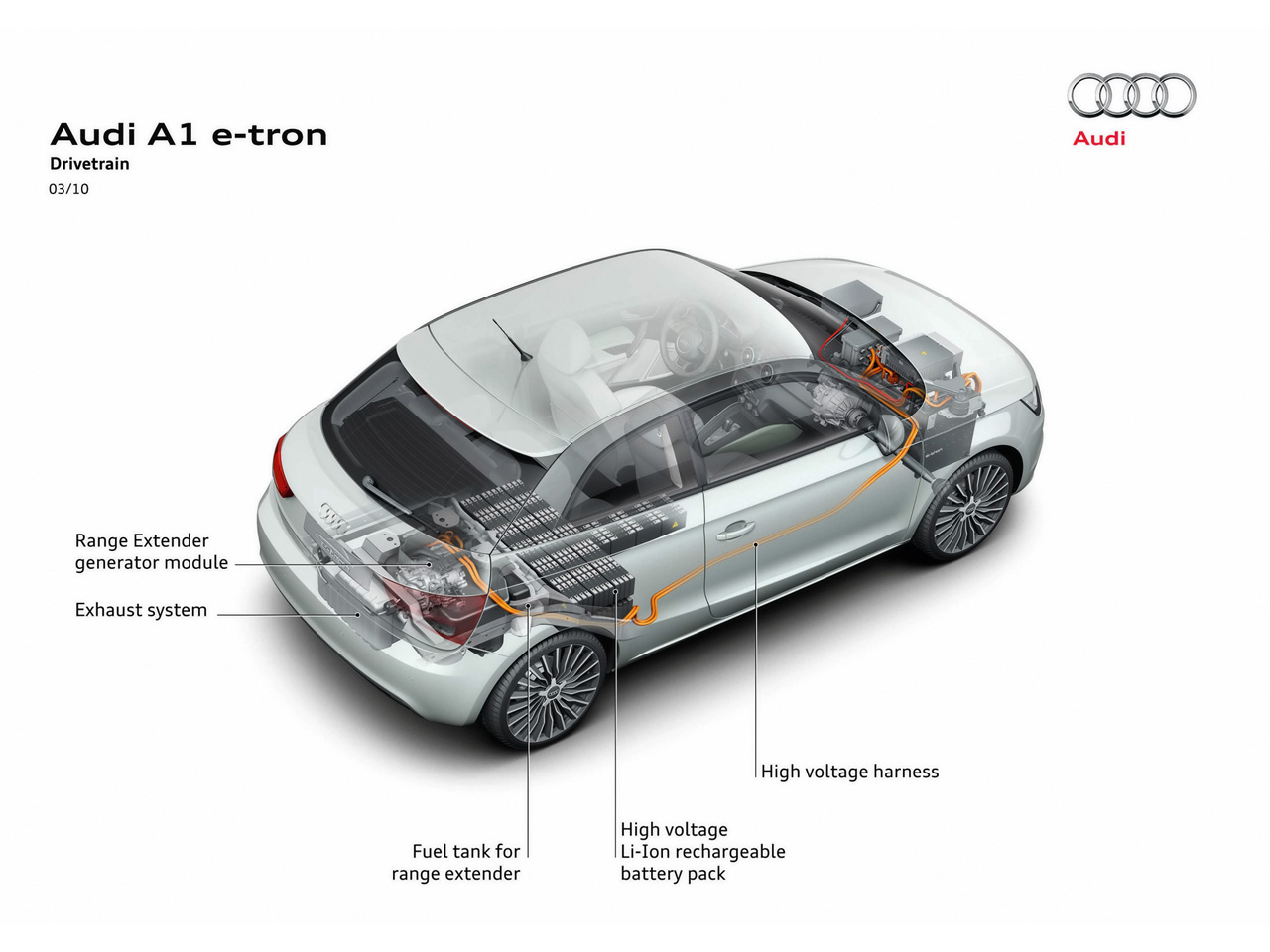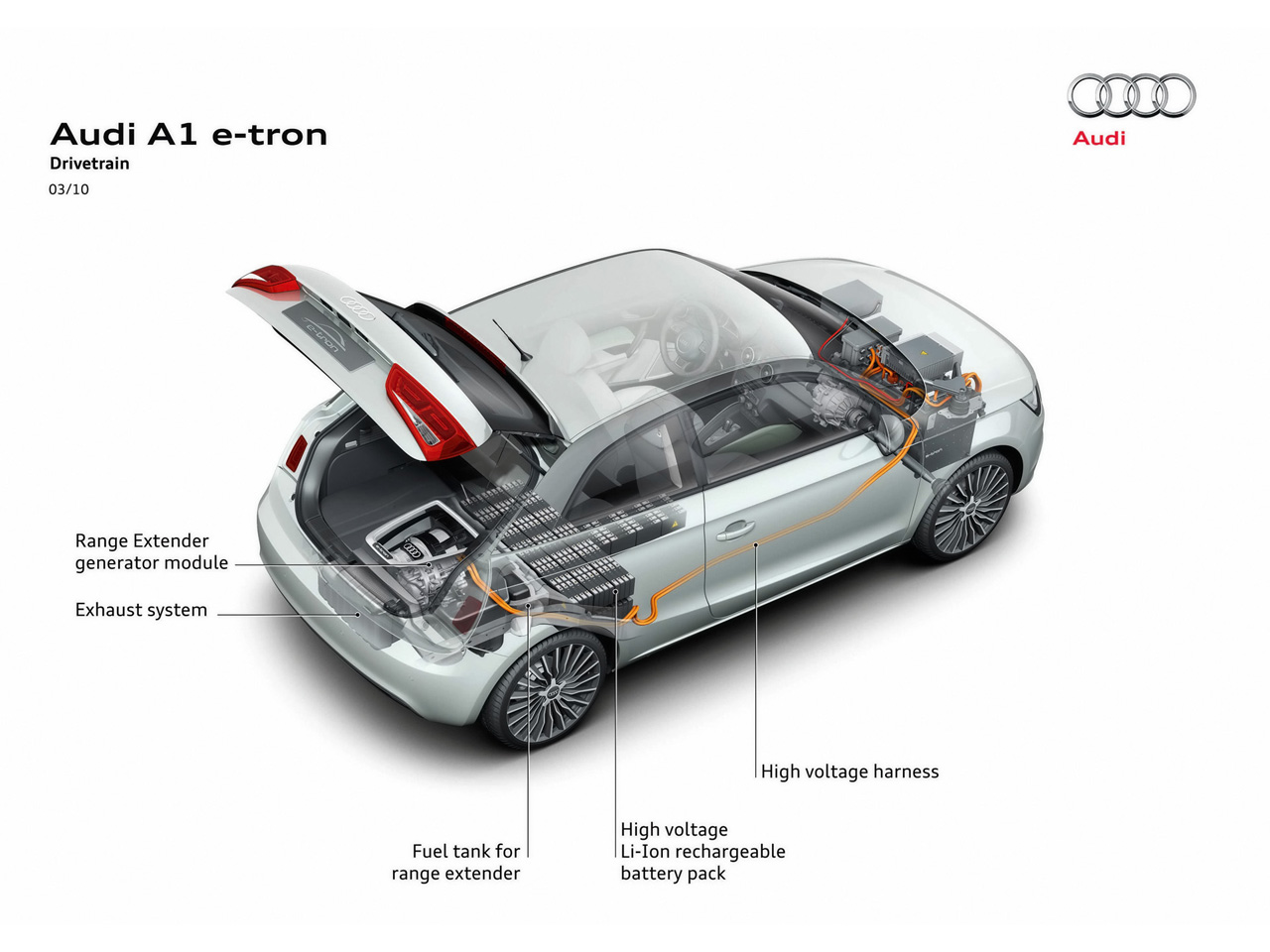2010 Audi A1 e-tron
|
Price |
-- |
Production |
-- | ||
|
Engine |
electric |
Weight |
-- | ||
|
Aspiration |
-- |
Torque |
177 lb-ft | ||
|
HP |
102 hp |
HP/Weight |
-- | ||
|
HP/Liter |
-- |
1/4 mile |
-- | ||
|
0-62 mph |
-- |
Top Speed |
-- |
(from Audi Press
Release) Audi A1 e-tron – electric driving in the city
The new e-tron model series from Audi will gain another new member
at the Geneva Motor Show: The Audi A1 e-tron is a Mega City Vehicle
(MCV) with an innovative drive technology. It comes equipped with a
powerful electric motor for zero-emission driving in the city. There
is also an internal combustion engine on board that recharges the
battery in exceptional circumstances. The A1 e-tron is very agile
thanks to the 75 kW (102 hp) peak power of its electric motor.
The technology of the Audi A1 e-tron
The e-tron model family
from Audi is just a few months old, but it already has a number of
members, for each of which Audi has chosen a different drive
technology. The first e-tron, which debuted at the 2009 IAA in
Frankfurt/Main, is a near-series high-performance sports car with
electric motors for all four wheels. The study shown at the Detroit
Motor Show in 2010 is a lightweight, compact two-seater with two
electric motors on the rear axle.
The A1 e-tron now presents another approach – a compact electric car
in the premium class. The four-passenger, two-door MCV city car was
designed specifically for use in the metropolitan areas of Europe
and North America and in the rapidly growing megacities of Asia and
South America. The Audi A1 e-tron always drives on electric power;
its internal combustion engine is only used to recharge the battery
in isolated cases.
The integration of the new technologies shows the holistic approach
that Audi is pursuing with electric mobility. The objective is to
use the energy with the lowest possible losses. The precise
interaction of the components, their intelligent packaging, and the
efficient management of the current flows are the product of the
expertise that the company has developed in this area.
Audi has developed a proprietary thermal management system to keep
the battery, the electric motor, and the power electronics within
their respective ideal temperature windows.
Behind the three e-tron models is a broadly diverse and modular
technology platform that continues to grow very rapidly as Audi
drives development forward.
The electric motor: 75 kW (102 hp) peak power
The synchronous electric
motor of the Audi A1 e-tron is mounted transversely at the front of
the car. Its low mounting position has a positive effect on the
vehicle's center of gravity. Continuous output is rated at 45 kW (61
hp), with peak power of 75 kW (102 hp) available in short bursts.
150 Nm (110.63 lb-ft) of torque is continuously available, and peak
torque is 240 Nm (177.01 lb-ft).
The electric motor sends its power to the front wheels via a
single-speed transmission. The elegant, retractable selector lever
on the console of the center tunnel used to choose between “Drive,”
“Reverse,” and “Neutral” was taken from the first Audi e-tron.
The power electronics are mounted in the engine compartment above
the electric motor. The most important components are the
pulse-controlled inverter, which serves as the controller between
the electric motor and the battery; the DC converter, which connects
the high-voltage network with the 14 volt electrical system; a
breaker unit to protect the high-voltage components; and the
charging module. The socket for the standard charging plug is
located behind the rings in the single-frame grille of the Audi A1
e-tron. A fully depleted battery can be recharged in approximately
three hours from the 380 volt grid. A display immediately adjacent
to the plug-in connection shows the current charge status and the
charging time remaining.
The concept of the innovative Mega City Vehicle requires the
electrification of key auxiliaries. The refrigerant compressor of
the climate control system, for example, is electrically powered by
a high-voltage electric motor that supplies only the amount of power
needed at the time.
This increases system efficiency substantially compared to
conventional concepts. Thanks to a special circuit, the climate
control loop also functions as a heat pump that regulates the
temperature of the cabin and the battery.
The power steering of the Audi A1 e-tron is electro-mechanical and
thus particularly energy-efficient. An electronic brake system makes
it possible to tap into the recuperation potential of the electric
motors. A hydraulic fixed-caliper brake is mounted on the front
axle, with two novel electrically-actuated floating-caliper brakes
mounted on the rear axle. These floating calipers are actuated not
by any mechanical or hydraulic transfer elements, but rather by wire
(“brake by wire”). In addition, this eliminates frictional losses
due to residual slip when the brakes are not being applied. In
addition, the servo unit received a new, demand-controlled electric
vacuum pump.
The large electric motor powering the A1 e-tron can convert braking
energy into electric current and feed it back into the electrical
system. The high degree of recuperation benefits overall efficiency.
The electric control actions are imperceptible to the driver, who
notices only the familiar, precise, and perfectly controllable pedal
feel.
The battery pack: a compact T arranged below the floor
The energy storage unit
is arranged below the floor, where it is ideal for the center of
gravity and weight distribution. The battery pack is shaped like a
T, with the short “transverse beam” filling the rear section of the
center tunnel and the “cross-beam” filling that area in front of the
rear axle where the fuel tank is otherwise located. The 380 volt
lithium-ion rechargeable battery has a nominal energy content of 12
kilowatt hours. It comprises 96 prismatic cells and weighs less than
150 kilograms (330.69 lb).
The Audi A1 e-tron can drive 50 kilometers (31.07 miles)
emission-free in city traffic on the powerful battery. On longer
trips, the battery is recharged by a particularly compact internal
combustion engine mounted below the luggage compartment.
The range extender
The A1 e-tron concept
car has a Wankel engine as a range extender, but other compact
concepts are also possible. The small single-rotor Wankel has a
chamber volume of 254 cc and runs at a constant 5,000 rpm in its
peak efficiency window. The electronics also consider navigation
data such as the destination and route profile to automatically
activate the range extender as needed. The driver can also turn the
range extender on and off as necessary with the push of a button The
fuel tank holds 12 liters (3.17 US gallons).
The great strengths of the Wankel engine are the nearly
vibration-free and quiet operation, the small dimensions, and the
extremely low weight. Together with the generator, which is powered
by the Wankel engine and produces 15 kW of electric power, the
complete assembly weighs only around 70 kilograms (154.32 lb). This
weight also includes the special power electronics, the intake,
exhaust, and cooling unit, plus the insulation and the subframe.
Driving experience
The first defining
impression that the driver of the Audi A1 e-tron gets is that of
nearly total silence. Even the Wankel engine in the back can barely
be heard when it is running.
The second characteristic perception is the power of the electric
motor, nearly all of which is available instantly and thrusts the
Audi A1 e-tron forward with authority. The innovative Mega City
Vehicle, which despite its complex drive technology weighs only
1,190 kilograms (2,623.50 lb) delivers zero-emission driving fun in
a modern and sophisticated manner. The vehicle accelerates from 0 to
100 km/h (62.14 mph) in 10.2 seconds and has a top speed of more
than 130 km/h (80.78 mph).
The Audi A1 e-tron can also cover longer distances if the range
extender charges the battery. The extra range, which is intended
primarily for interurban driving, is 200 kilometers (124.27 miles).
According to the draft standard, the two different operating modes
yield a fuel consumption of only 1.9 l/100 km (123.80 US mpg), which
corresponds to CO2 emissions of 45 g/km (72.42 g/mile). In electric
mode, there are zero local CO2 emissions - the compact A1 e-tron is
thus ecological and economical.
The third impression that the A1 e-tron makes is that of a larger
car. The compact two-door boasts all of the strengths of the new A1
model series – the carefully tuned, sporty chassis with specially
designed 18 inch alloy wheels and 215/35 R18 tires; the generous,
“grown-up” interior; the excellent fit and finish; and a multitude
of high-end equipment.
The dark shade “ebony” dominates the interior. The seats – with
stone gray seams – and the headliner are in “Alabaster White".
Design
The concept car in
Geneva has a special “Aqua Mint, pearl effect” paint finish; the
contrasting roof arch is offset in “High Gloss Steel dark.” As with
the other two e-tron models, the 18-inch wheels with a 20-spoke
turbine design convey the high-tech aspiration of the concept.
The rear diffuser with aluminum trim lacks tailpipes. This
emphasizes the width of the vehicle and suggests the low emissions.
The two front fenders are emblazoned with the “e-tron” logo.
The “Aqua Mint, pearl effect” exterior color carries over into the
interior, where it adorns the door panels and the center console.
The shift lever is a special leather-wrapped design; as is typical
for the e-tron models, the start-stop button was placed in the front
of the center console. A specially designed battery cover at the
front of the car and the range extender engine with its cooling fins
displayed under a sheet of glass in the luggage compartment also
serve to visually underscore the clean technology of the A1 e-tron.
And because an innovative drive concept also calls for innovative
information management, the concept car features a freely
programmable instrument cluster with a virtual display surface and
innovative display and operating concept.
The equipment and data specified in this document refer to the model
range offered in Germany. Subject to change without notice; errors
and omissions excepted.



